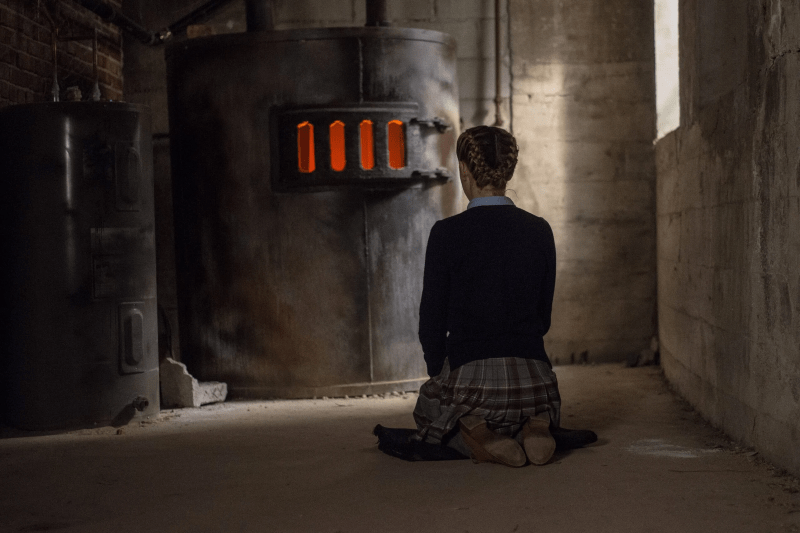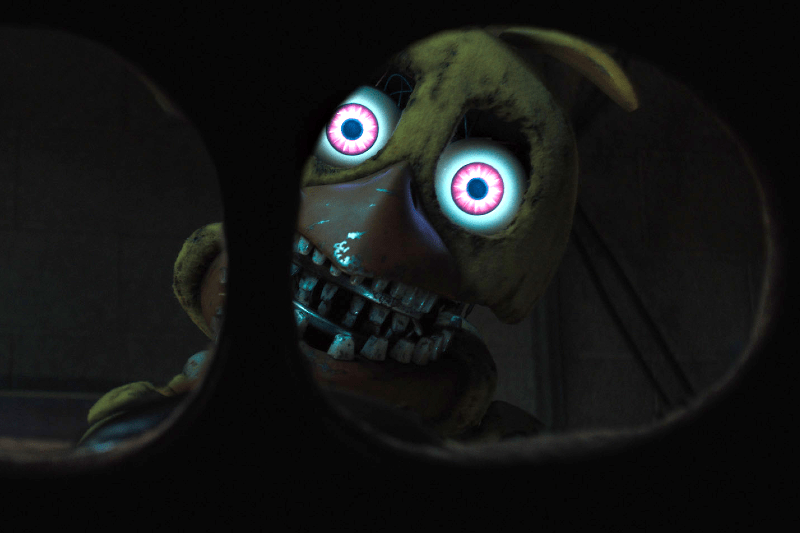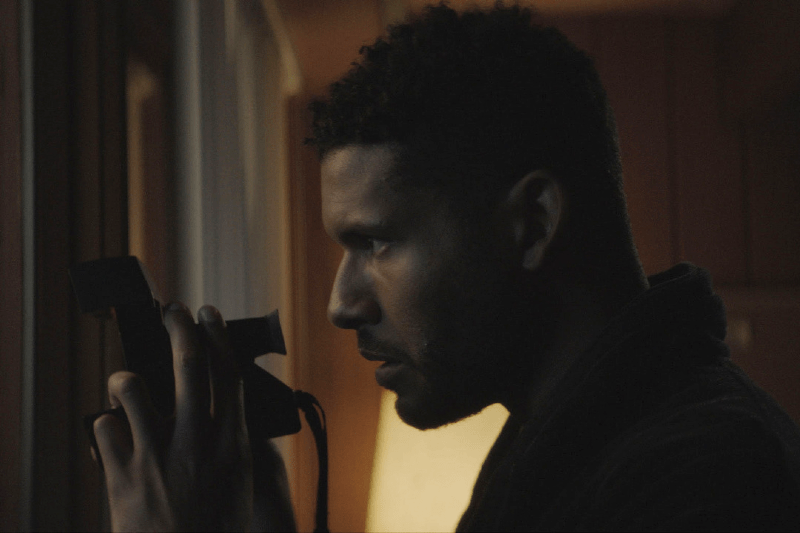With the recent success of Longlegs and The Monkey, writer and director Osgood Perkins is a quickly rising star in the horror genre. Yet, his first feature film, The Blackcoat’s Daughter, might still be his most compelling work to date. Originally premiering at film festivals in 2015 before a small theatrical release in 2017, The Blackcoat’s Daughter emerged right when A24 was gaining momentum. Despite being an A24 film, and the positive critical response, this film about the dangerous mind of a lonely teenage girl has remained somewhat overlooked.
The Blackcoat’s Daughter begins by introducing two teenage girls who attend a private girls’ boarding school. Kat (Kiernan Shipka) is an impressionable young freshman, who, on the eve of a Parents’ Day at school, has a dream about a man in a black coat appearing to her. The man shows Kat a car wreck on a remote and snowy road; when Kat awakens, she’s convinced her parents are dead. At the same time, senior Rose (Lucy Boynton) lies to her parents about pick-up day so she can meet up with her boyfriend and tell him she might be pregnant. These two very different young women end up stuck together when they’re the only two students not picked up by their parents.
The audience watches as Kat becomes more withdrawn, looking sickly and behaving strangely. After Rose returns from her date and discovers she’s gotten her period, she hears strange noises coming through the vents. She follows the noise into the basement to find Kat in front of the furnace, seemingly praying to the flames within. Rose gets Kat cleaned up and to bed, confused, angry, and somewhat afraid. Before leaving Kat, Rose asks if she needs anything else. Kat simply responds, “You had your chance.”
The next day Rose and Kat go to have breakfast with two staff members who have agreed to care for the girls until their parents come. At breakfast, Kat refuses to say grace before calling the women “cunts” and vomiting at the table. Rose is sent away to shovel snow, then goes to take a nap after. During that time, Kat stabs the two staff members to death before beheading them. She then does the same to Rose. When a cop finally gets to the school and sees the carnage, he follows the blood down to the basement. Once again, Kat is praying before the furnace, this time with the heads of the three women she killed placed next to her. Kat stands, knife in hand, and repeats “hail Satan” before the cop shoots her.
There are two different ways one could look at Kat’s story in The Blackcoat's Daughter. From the moment she had the dream, a dark, shadowy figure loomed in the background of her life; first appearing as a man in a black coat, then later as a cloaked figure with large horns. The easiest read here is that a demon came to Kat and eventually possessed her, forcing her to kill those poor women. It seems, in the beginning, that Kat fought the demon. She sought help from the school priest, trying to convince him to stay for her piano recital on Parents’ Day, but he abandoned her. After Kat’s parents didn’t come for her, she sought help from the school headmaster, trying to convince him to let her live at school. Finally, she sought help from Rose, asking her to stay and take care of her (as the headmaster instructed) rather than sneaking out to meet her boyfriend. Kat felt she had no one, so she turned to the entity giving her attention.
Intercut with Rose and Kat’s story, we watch the story of “Joan” (Emma Roberts), a young woman who’s just escaped from a mental institution. As she tries to determine her next move, she meets Bill (James Remar) and Linda (Lauren Holly), a married couple driving the same way Joan is going. Bill is incredibly kind and offers to give Joan a ride so she doesn’t freeze in the snow. Eventually, it’s revealed that “Joan” is really Kat, having taken the identity of a woman she killed during her escape. Even more shocking, Bill and Linda happen to be Rose’s parents, on their way to visit her gravesite on the anniversary of Rose’s death.
Joan/Kat takes this as a sign, tricking the couple into stopping on the side of the road near the now abandoned boarding school. She stabs the couple to death and beheads them, just as she did 9 years earlier. She takes the heads to the basement and finds the furnace, cold from years of non-use. Realizing the flames and the demonic entity are gone, Joan/Kat returns to the road and cries, unsure of what she’s supposed to do and feeling more alone than ever before.
This new timeline in Kat’s story casts some doubt on whether or not the demon was real. The demonic argument is certainly there for the reading. Kat is young, impressionable, and doesn’t seem to have any real friends at school. When the authority figures around Kat also fail her, despite her subtle pleas for help, she becomes easy prey for evil. The school priest is even shown doing an exorcism on Kat as she lies strapped to a hospital bed after being shot by the cop. She asks the demon not to leave her alone, but it goes anyway.
Yet when we watch Kat as Joan, another potential explanation arises. Joan thinks running into Rose’s parents, on the anniversary of the killings and so close to the school, is a sign from the demon. She carries out what she believes is his will, hoping the demon will return to her and she won’t be alone. But the demon doesn’t come. Kat/Joan is still alone, and she killed two innocent people for nothing. When she cries in the wake of her actions, are the tears because she thinks the demon has abandoned her, or are they because she finally realized it was all a lie?
Perhaps, instead of evil influencing Kat, it was unresolved mental health issues. When the dreams, voices, and visions first start, Kat is afraid. Since she has no peers she is close with, she looks to the authority figures most children would turn to for help. She calls her parents, speaks with the priest and the headmaster, and even turns to Rose, who in Kat’s eyes is an authority figure. Rose is a senior who is popular, beautiful, and speaks with a confidence that makes it seem (at least from the outside) she has her life together. It isn’t until Kat feels abandoned by all these people that she finally succumbs to the “evil.” With everything she sees and hears in The Blackcoat's Daughter, it seems likely Kat might suffer from an undiagnosed mental illness such as schizophrenia. If any of the adults had paid attention and listened to Kat when she was clearly seeking help, then perhaps she could have been treated with medication and therapy.
If it was all in Kat’s head, it could better explain her final moments as Joan. Being in a mental health facility, Kat/Joan surely would have been medicated. That medication would keep Kat from seeing or hearing anything new, but it wouldn’t erase the things she saw and heard before being put away. The coincidences after she escapes likely looked like signs to her, encouraging her on this dark path. When Kat/Joan doesn’t see the demon, even after recreating the murders with new victims, it might finally have convinced her what she saw nine years ago wasn’t real. It was all in her head.
Whether demonic possession or mental health crisis, Kat’s Uterus Horror journey in The Blackcoat’s Daughter is a tragic one. As a freshman in high school, making Kat just about 14 years old, she would have been at a vulnerable point in her life. It’s not only her first year of high school, she’s also separated from her parents and her other systems of support. Isolated and without any school friends, Kat had to rely on the adults in her life, but those adults failed her. Without that support system, Kat had no guidance during this time of change in her life, making her more susceptible to sinister forces and/or mental illness. If even one of those adults had paid attention, Kat’s story could have ended quite differently. Perkins masterfully crafted this Uterus Horror story, perfectly conveying how dangerous loneliness can be on a young, fragile mind.
About this series: in a genre typically considered “for the guys,” it’s time to give a nod to the ladies. Uterus Horror is a subgenre of horror films that focuses on the uniquely female experience of puberty and the act of coming into your sexuality, using horror elements to emphasize and/or act as a metaphor for that experience. These films are often ignored in theaters but quickly develop cult followings. Columnist Molly Henery, who named and defined the subgenre, tackles a new film each month and analyzes how it fits into this bloody new corner of horror.






